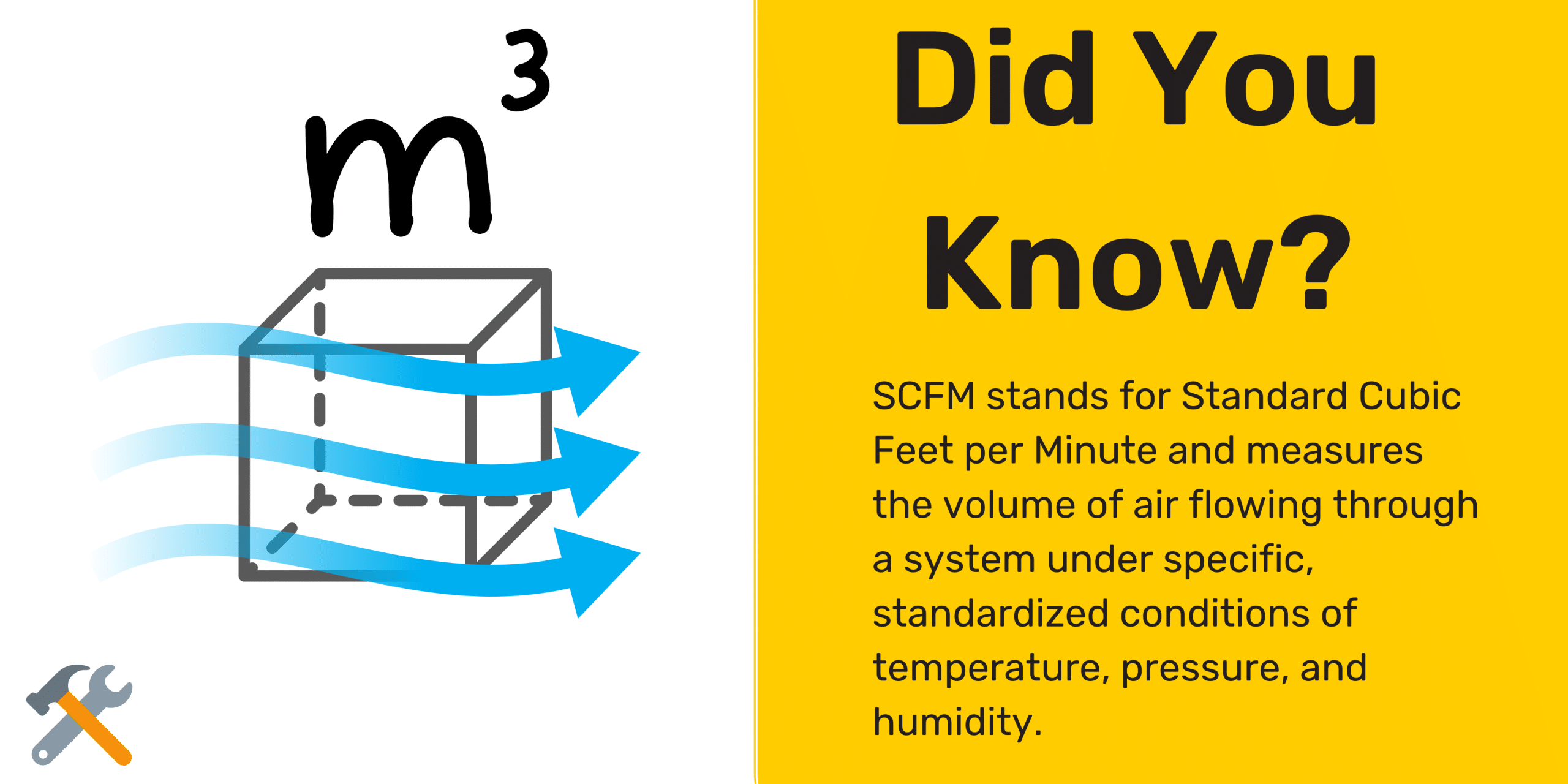Super - you are in the right place online.
In this ToolsGaloreHQ guide, you will learn:
- What exactly SCFM means;
- How it compares with other cubic measurements;
- And So Much More

SCFM, or Standard Cubic Feet per Minute, is a critical measurement in the realm of airflow. It serves as a benchmark for evaluating air compressor performance under standardized conditions.
Understanding SCFM is essential for making informed decisions regarding equipment selection.
However, its significance extends beyond mere definition. Various airflow measurements exist, each serving distinct applications. Exploring these differences can shed light on optimal compressor usage and efficiency. What are the nuances that set SCFM apart from other metrics?
Why this guide on what does SCFM mean
Understanding the significance of SCFM is essential for anyone involved in air compressor operations or pneumatic tool usage. This guide serves as a beacon of clarity, illuminating the critical role SCFM plays in ensuring optimal performance and efficiency.
Knowledge of SCFM empowers individuals to select the appropriate compressors for their specific needs, liberating them from the constraints of subpar equipment. By grasping the nuances of airflow measurements, users can make informed decisions that enhance their operational capabilities.
This guide not only demystifies SCFM but also encourages a proactive approach to equipment choice, ultimately fostering a more efficient, empowered work environment. Embracing this understanding paves the way for greater autonomy in managing air compressor systems and pneumatic tools effectively.
Read More:>>> Rotary compressors explained
How does SCFM differ from CFM
How can one accurately assess the differences between SCFM and CFM?
SCFM, or Standard Cubic Feet per Minute, measures airflow under controlled conditions: a temperature of 68°F, pressure at 14.7 psi, and 36% humidity.
In contrast, CFM, or Cubic Feet per Minute, reflects actual airflow influenced by varying environmental factors, often yielding lower values than SCFM.

This distinction is crucial for those seeking liberation from inefficiencies, as SCFM provides a consistent benchmark for comparing compressor performance.
Understanding these differences empowers users to select the appropriate air compressor, ensuring optimal tool operation.
Hence, while SCFM offers idealized performance metrics, CFM delivers the real-world application necessary for effective and efficient air system management.
How does SCFM differ from ACFM
What distinguishes SCFM from ACFM? SCFM, or Standard Cubic Feet per Minute, measures airflow under standardized conditions, ensuring consistent comparison across different systems.
In contrast, ACFM, or Actual Cubic Feet per Minute, reflects the true flow rate without regard to those standard conditions. This fundamental difference lies in the variable elements of temperature, pressure, and humidity that affect ACFM.
As such, SCFM is typically higher than ACFM, as it accounts for ideal conditions that may not occur in practice.
Understanding this distinction is vital for those seeking liberation from inefficiencies in air compressor selection, allowing for more informed decisions that align with the demands of specific applications and environments.
Knowledge empowers users to optimize performance and resource utilization.
Read More:>>> French presta valve explained simply
How does SCFM differ from ICFM
SCFM, or Standard Cubic Feet per Minute, and ICFM, or Indicated Cubic Feet per Minute, represent different measurements of airflow in air compressors.
SCFM quantifies airflow under standardized conditions (temperature, pressure, and humidity), allowing for consistent comparisons across various compressors. In contrast, ICFM measures the actual airflow as indicated by the compressor's gauges, which may fluctuate based on environmental factors and operational conditions.
This distinction is critical for users seeking optimal performance; while SCFM provides a baseline for efficiency, ICFM reflects real-time performance.
Understanding these differences empowers users to make informed decisions, ensuring they select the right equipment for their needs and liberating them from inefficiencies and miscalculations in their operations.
Frequently Asked Questions
How Does Temperature Affect SCFM Readings in Air Compressors?
Temperature significantly influences SCFM readings in air compressors; warmer air increases the volume, resulting in higher CFM, while colder air decreases it, impacting overall efficiency and performance under varying atmospheric conditions.
What Tools Typically Require High SCFM Ratings?
Tools that typically require high SCFM ratings include spray guns, pneumatic chisels, sanders, and impact wrenches. These applications demand significant airflow to operate efficiently, ensuring optimal performance and achieving desired results in various tasks.
Read More:>>> Have you ever considered cutting on wet grass
Can SCFM Values Change With Altitude?
Yes, SCFM values can change with altitude. As altitude increases, atmospheric pressure decreases, which leads to lower SCFM readings for air compressors, impacting their efficiency and performance in various applications requiring specific airflow rates.
How Is SCFM Calculated for Different Air Conditions?
SCFM is calculated by considering factors like temperature, pressure, and humidity. It involves measuring airflow under specified conditions, adjusting for variations in altitude and atmospheric pressure to achieve accurate airflow rates essential for optimal compressor performance.
What Are the Implications of Insufficient SCFM for Tools?
Insufficient SCFM for tools leads to inadequate airflow, resulting in reduced efficiency, subpar performance, and increased wear on equipment. This impacts productivity, necessitating careful selection of compressors to meet specific air demands for optimal operation.
Final thoughts on what does SCFM mean
Understanding the significance of Standard Cubic Feet per Minute (SCFM) is essential for anyone involved in the use or selection of air compressors. SCFM serves as a vital benchmark for evaluating airflow under standardized conditions, enabling users to make informed decisions about compressor performance.
By grasping the difference between SCFM and CFM, individuals can better assess their specific needs, ensuring efficient operation and energy usage. Moreover, recognizing how SCFM influences tool compatibility and performance empowers users to select equipment that meets or exceeds required airflow rates.
Ultimately, a thorough comprehension of SCFM fosters not only operational efficiency but also the potential for enhanced productivity, liberating users from the constraints of inadequate air supply and enabling them to achieve their project goals with confidence.
In conclusion, understanding SCFM is essential for anyone involved in selecting or utilizing air compressors and pneumatic tools. By distinguishing SCFM from other airflow measurements like CFM, ACFM, and ICFM, users can make informed decisions that enhance efficiency and performance in their operations. This standardized metric serves as a reliable benchmark, ensuring compatibility and optimal functionality across various industrial applications. Ultimately, a solid grasp of SCFM contributes to improved productivity and effectiveness in airflow management.





